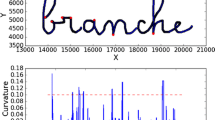Abstract
Handwriting is an important issue in Taiwan’s school system, and it remains to be determined if tablet computers are a suitable medium for the development of good handwriting. The primary purpose of this study is to determine whether visual and tactile instructional strategies can be used to help students improve their handwriting performance. The study recruited 31 6th grade elementary school students to hand write a short phrase on backgrounds of various colors (white, red, yellow, green and blue), both on pen and on tablet computer. Finally, a questionnaire was administered to determine emotional associations with the various background colors. Results showed that media type does have an impact on handwriting performance, with familiar media (paper) providing better results. Descriptive statistics indicate that using a red background provided the best subjective and objective performance, and consistently produced characters of better proportional size. Red was also found to have an emotional association with excitement and triggered positive emotions among the students.
Chapter PDF
Similar content being viewed by others
References
Arnold, E.C.: Ink on paper 2: a handbook of the graphic arts. Harper and Row, New York (1972)
Boyatzis, C.J., Varghese, R.: Children’s emotional associations with colors. The Journal of Genetic Psychology 155(1), 77–85 (1994)
Fordham, D.R., Hayes, D.C.: Worth repeating: Paper color have an effect on student performance. Issues in Accounting Education 24(2), 187–194 (2009)
Hulls, C.C.W.: Using a Tablet PC for classroom instruction. In: Paper Presented at the Proceedings of the 35th Annual Conference Frontiers in Education, FIE 2005 (2005)
Iovino, I., Fletcher, J.M., Breitmeyer, B.G., Foorman, B.R.: Colored overlays for visual perceptual deficits in children with reading disability and attention deficit/hyperactivity disorder: Are they differentially effective? Journal of Clinical and Experimental Neuropsychology 20(6), 791–806 (1998)
Lam, S.S., Au, R.K., Leung, H.W., Li-Tsang, C.W.: Chinese handwriting performance of primary school children with dyslexia. Research in Developmental Disabilities 32(5), 1745–1756 (2011)
Lin, H., Luo, M., MacDonald, L., Tarrant, A.: A cross-cultural colour-naming study. Part III—A colour‐naming model. Color Research & Application 26(4), 270–277 (2001)
Luria, G., Rosenblum, S.: Comparing the handwriting behaviours of true and false writing with computerized handwriting measures. Applied Cognitive Psychology 24(8), 1115–1128 (2010)
McClanahan, B., Williams, K., Kennedy, E., Tate, S.: A Breakthrough for Josh: How Use of an iPad Facilitated Reading Improvement. TechTrends 56(3), 20–28 (2012)
Rosenblum, S., Chevion, D., Weiss, P.L.: Using data visualization and signal processing to characterize the handwriting process. Developmental Neurorehabilitation 9(4), 404–417 (2006)
Sinclair, R.C., Soldat, A.S., Mark, M.M.: Affective cues and processing strategy: Color-coded examination forms influence performance. Teaching of Psychology 25(2), 130–132 (1998)
Terwogt, M.M., Hoeksma, J.B.: Colors and emotions: Preferences and combinations. The Journal of General Psychology 122(1), 5–17 (1995)
Tharangie, K., Marasinghe, A., Yamada, K.: When Children Sense in Colours: Determinants of Colour-Emotion Associations. In: Paper Presented at the International Conference on Biometrics and Kansei Engineering, ICBAKE 2009 (2009)
Tucha, O., Mecklinger, L., Walitza, S., Lange, K.W.: Attention and movement execution during handwriting. Human Movement Science 25(4), 536–552 (2006)
Author information
Authors and Affiliations
Editor information
Editors and Affiliations
Rights and permissions
Copyright information
© 2014 Springer International Publishing Switzerland
About this paper
Cite this paper
Yang, CY., Hsu, WL., Huang, TY.C. (2014). The Impact of Media and Background Color on Handwriting. In: Marcus, A. (eds) Design, User Experience, and Usability. User Experience Design for Everyday Life Applications and Services. DUXU 2014. Lecture Notes in Computer Science, vol 8519. Springer, Cham. https://doi.org/10.1007/978-3-319-07635-5_18
Download citation
DOI: https://doi.org/10.1007/978-3-319-07635-5_18
Publisher Name: Springer, Cham
Print ISBN: 978-3-319-07634-8
Online ISBN: 978-3-319-07635-5
eBook Packages: Computer ScienceComputer Science (R0)




